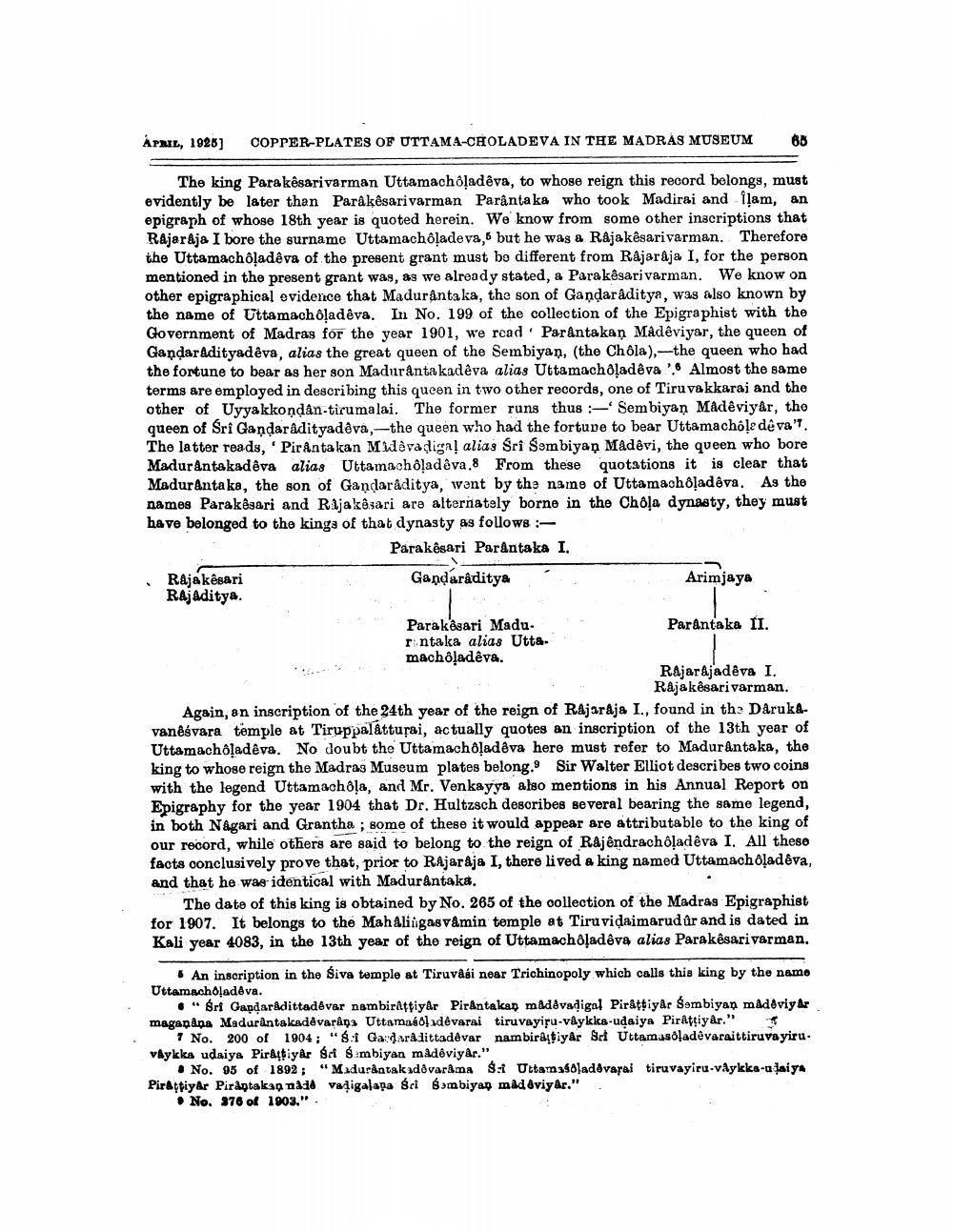________________
APRIL, 1025)
COPPER-PLATES OF UTTAMA-CHOLADEVA IN THE MADRAS MUSEUM
AB
The king Para kêsarivarman Uttamachôladeva, to whose reign this record belonge, must evidently be later than Parakêsarivarman Parânta ka who took Madirai and ļam, an epigraph of whose 18th year is quoted herein. We know from some other inscriptions that Rajaraja I bore the surname Uttamachôladeva, but he was a Rajakesari varman. Therefore the Uttamachôľadêva of the present grant must be different from Rajaraja I, for the person mentioned in the present grant was, as we already stated, a Parakêsari varman. We know on other epigraphical evidence that Madurânta ka, the son of Gandaraditya, was also known by the name of Uttamach ladêva. In No. 199 of the collection of the Epigraphist with the Government of Madras for the year 1901, we read' Parântakan Madêviyar, the queen of Gandaradityadêva, alias the great queen of the Sembiyan, (the Chola),--the queen who had the fortune to bear as her son Madurantakadeva alias Uttamachoľadêva'. Almost the same terms are employed in describing this queen in two other records, one of Tiruvakkaraj and the other of Uyyakkondan-tirumalai. The former runs thus Sembiyan Madêviyar, the queen of Sri Gandaradityadêva,-the queen who had the fortune to bear Uttamachóļe dê va'. The latter reads, 'Pirántakan Mwêvadical alias Sri Sembiyan Madêvi, the queen who bore Madurantakadêva alias Uttamachôļadêva.8 From these quotations it is clear that MadurAntaka, the son of Gandaraditya, went by the name of Uttamaohladêva. As the names Parakesari and Rajak@sari are alternately borne in the Choļa dynasty, they must have belonged to the kings of that dynasty as follows:
Parakesari Parântaka I. Rajakesari Gandarâditya
Arimjaya Rajaditya. Parakesari Madu.
Parantaka II. rintaka alias Utta. macholadêva.
Rajarajadêva I.
Rajakesari varman. Again, an inscription of the 24th year of the reign of Rajaraja I., found in tho Darukavanêsvara temple at Tiruppalattusai, actually quotes an inscription of the 13th year of Uttamachôladêva. No doubt the Uttamachôladeva here must refer to Madurântaka, the king to whose reign the Madras Museum plates belong. Sir Walter Elliot describes two coins with the legend Uttamachôļa, and Mr. Venkayya also mentions in his Annual Report on Epigraphy for the year 1904 that Dr. Hultzsch describes several bearing the same legend, in both Nagari and Grantha ; some of these it would appear are attributable to the king of our record, while others are said to belong to the reign of Rajendrachôladêva I. All these facts oonclusively prove that, prior to RAjaraja I, there lived a king named Uttamach ladeva, and that he was identical with Madurântaka.
The date of this king is obtained by No. 265 of the collection of the Madras Epigraphist for 1907. It belongs to the Mahalingasvâmin temple at Tiruvidaimarud ûr and is dated in Kali year 4083, in the 13th year of the reign of Uttamachôļadêva alias Parakesarivarman.
• An inscription in the siva temple at Tiruvasi near Trichinopoly which calls this king by the name Uttamacho adeva.
." Sri GandarAdittadevar nambirattiyâr Pirántakan madàvadigal Pirâtiyar Sombiyan madaviya magapana Madurantakaddvarás Uttamasoudêvarai tiruvayiru-vâykka-udaiya PirAttiyar."
7 No. 200 of 1904; "6.1 Ga: darálittadêvar nambiratiyar Set Uttamasóladevaraittiruvayiru vlykke udsiya PirAttiyar ød Sambiyan madêviyar."
• No. 05 of 1892; “Madurântakadêvarêma $: Uttamasdladdvarai tiruvayiru-väykka-ulaiya PiratiyAr Piraptakap nådd vaļigala a sci fumbiyan madaviyar."
• No. 376 of 1903." .




